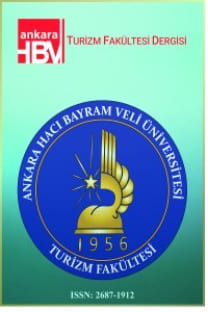İçsel ve Dışsal Motivasyon Araçlarının İşgörenlerin Motivasyonu Üzerindeki Etkisi: Ampirik Bir İnceleme
İşgörenleri motive etmeye yönelik olarak geçmişten günümüze çeşitli motivasyon araçlarından yararlanılmıştır. Bu çalışmada motivasyon araçları başlıca motivasyon teorilerinin sentezinden hareketle içsel ve dışsal motivasyon araçları olarak iki grupta ele alınmıştır. İçsel ve dışsal motivasyon araçlarının işgörenlerin motivasyonu üzerinde etkili olup olmadığını ve işgörenleri motive etmesi açısından söz konusu motivasyon araçlarının farklılık gösterip göstermediğini ortaya koymak amacıyla Afyonkarahisar il merkezinde yerleşik termal otel işletmelerinde bir araştırma yapılmıştır. Araştırmada veri toplama aracı olarak anket formu kullanılmıştır. Araştırma sonucunda elde edilen bulgular, hem içsel hem de dışsal motivasyon araçlarının işgörenlerin motivasyonu üzerinde etkili olduğunu ortaya koymuştur. İçsel motivasyon araçlarının işgörenlerin motivasyonu üzerindeki etkisinin dışsal motivasyon araçlarına göre daha yüksek olduğu saptanmıştır. İçsel ve dışsal motivasyon araçlarının işgörenlerin motivasyonu üzerindeki etkisinin cinsiyete, çalışılan departmana, yaşa ve çalışma süresine göre farklılık göstermediği anlaşılmıştır
Anahtar Kelimeler:
Motivasyon, içsel ve dışsal motivasyon araçları
THE EFFECTS OF INTRINSIC AND EXTRINSIC MOTIVATION TOOLS ON EMPLOYEES’ MOTIVATIONS: AN EMPIRICAL INVESTIGATION
From past to the present day, different motivations tools have been used as regard to motivate employees. In this study, on the basis of a synthesis of motivation theories, motivation tools are considered as intrinsic and extrinsic in two groups. In order to determine whether intrinsic and extrinsic motivation tools have any effect on employees’ motivations and if these motivation tools differ in terms of their effects, a study was conducted in thermal hotels located in Afyonkarahisar. Data has been collected through a survey. Results obtained from the investigation of the data suggest that both intrinsic and extrinsic motivation tools are effective in motivating employees. In addition, intrinsic motivation tools are found to be more effective than extrinsic motivation tools in affecting employees’ motivations. On the other hand, the effects of intrinsic and extrinsic motivation tools on employee’s motivations do not differ according to gender, age, department, and working time
Keywords:
Motivation, intrinsic and extrinsic motivation,
___
- BRIEF P., Arthur ve ALDAG, Ramon J. (July 1976), The Instrinsic-Extrinsic Dichotomy: Toward Conceptual Clarity, Academy of Management Review, pp. 496-500.
- BRISLIN, Richard W., KABIGTING, Florencio, MACNAB, Brent, ZUKIS, Bob, WORTHLEY, Reginald (2005), Evolving Perceptions of Japanese Workplace Motivation, International Journal of Cross Cultural Management, Vol: 5, No: 1, pp.87-103.
- CHEN, Chao C., FORD, Cameron M. (1999), Do Rewards Benefit the Organization? The Effects of Reward Types and the Perceptions of Diverse R & D Professionals, IEEE Transactions on Engineering Management, Vol: 46, No: 1, pp.47-55.
- DE VOE, Sanford E. ve IYENGAR, Sheena S. (2004), Managers’ Theories of Subordinates: A Cross-Cultural Examination of Manager Perceptions of Motivation and Appraisal of Performance, Organizational Behavior and Human Decision Processes, Vol: 93, pp. 47-41.
- FISHER, D. Cynthia ve YUAN, Ya Xue (1998), What Motivates Employees? A Comparison of US and Chinese Responses, The International Journal of Human Resource Management, Vol: 9, No: 3, pp.516-528.
- HACKMAN, J, Richard ve LAWLER, Edward., E. (1971), Employee Reactions to Job Characterstics, Journal of Applied Psychology Monograpy, Vol.55, pp.259- 286.
- HACKMAN, J, Richard ve OLDHAM Grey R., (1975), Development of the Job Diagnostic Survey, Journal of Applied Psychology, Vol: 60, pp. 159-170.
- JONES-BASSETT, Nigel, LLOYD, C. Geoffrey (2005), Does Herzberg’s Motivation Theory Have Staying Power?, The Journal of Management Development, Vol. 24, No: 10, pp.929-943.
- KOVACH, A. Kennth (1987), What Motivates Employees? Workers and Supervisors Give Different Answers, Business Horizons, Vol: 30, No: 5, pp. 58-66.
- LATHAM,, P.Gary ve PINDER, C. Craig (2005), Work Motivation Theory and Research At The Dawn of the Twenty-First Century, Annual Review of Psychology, Vol: 56, No: 1, pp. 485-516.
- LEETE, Laura (2000), Wage Equity and Employee Motivation in Nonprofit and For- Profit Organizations, Journal of Economic Behaivor and Organization, Vol: 43, pp.423-446.
- LEONARD, H. Nancy, BEAUVAIS L. Laura ve SCHOLL, W. Richard (1999), Work Motivation: The Incorporation of Self-Concept-Based Processes, Human Relations, Vol: 52, No: 8, pp. 969-974.
- MAHANEY C. Robert ve LEDERER Albert L. (2006), The Effect of Intrinsic and Extrinsic Rewards for Developers on Information Systems Project Success, Project Management Journal, Vol: 37, No: 4, pp.42-54.
- MAK, Brenda L. ve SOCKEL, Hy (2001), A Confirmatory Factor Analysis of IS Employee Motivation and Retention, Information and Management, Vol: 38, pp.265-276.
- MOTTAZ J. Clifford (1985), The Relative Importance of Intrinsic and Extrinsic Rewards as Determinants of Wok Satisfaction, The Sociological Quarterly, Vol: 26, No: 3, pp.365-385.
- ÖZDAMAR, Kazım (2004) Paket Programlar İle İstatistiksel Veri Analizi I, Kaan Kitabevi, Eskişehir
- ROBBINS, Stephen P. (1993), Organizational Behavior (6ed.), Englewood Cliffs: Prentice-Hall.
- ROSS, Darren Lee (1995), Attitudes and Work Motivation of Subgroups of Seasonal Hotel Workers, The Services Industries Journal, Vol: 15, No: 3, pp.295-313.
- SHAMIR, Boas (1990), Calculations, Values and Identites: The Source of Collective Work Motivation, Human Relations, Vol: 43,No: 4, pp. 313-332.
- STEERS, M. Richard, MOWDAY, T. Richard ve SHAPIRO, L. Debra (2004), The Future of Work Motivation Theory, Academy of Management Review, Vol: 29, No: 3, 379-387.
- WIERSMA, Uco J. (1992), The Effects of Extrinsic Rewards in Intrinsic Motivation: A Meta Analysis”, Journal of Occupational and Organizational Psychology, Vol: 65, No: 2, pp. 101-114.
- WILEY, Carolyn (1997), What Motivates Employees According to Over 40 Years of Motivation Surveys, International Journal of Manpower, Vol: 18, No: 3, pp.263-280.
- ISSN: 2687-1912
- Yayın Aralığı: Yılda 2 Sayı
- Başlangıç: 1998
- Yayıncı: Ankara Hacı Bayram Veli Üniversitesi
Sayıdaki Diğer Makaleler
Fonksiyonel Olmayan Tüketici Davranışlarının Kavramsal Boyutu
Feride Bahar ÖZDOĞAN, Sanem ALKİBAY
Finansal Kiralama ve İMKB'de İşlem Gören Şirketlerde Kullanılma Düzeyi
Veli ÖZTÜRK, Hasan BAL, Emine Çına BAL
Yüksel ÖZTÜRK, Uğur AKDU, Serap Akasya AKDU
Enflasyon Muhasebesinde Kullanılan Yöntemlerin Karşılaştırılmalı Analizi
Fevzi Serkan ÖZDEMİR, Seçkin ARSLAN
Bahtışen KAVAK, Nilüfer VATANSEVER
Türk Turizm Sektöründe Tur Operatörleri ve Seyahat Acentaları
Faruk ALAEDDİNOĞLU, Ali Selçuk CAN
M Sabri KOCAKÜLAH, Erkan DURAN
Süleyman DÜNDAR, Hatice ÖZUTKU, Fatih TAŞPINAR
Finansal Kiralama ve İMKB'de İşlem Gören Şirketlerde Kullanılma Düzeyi
